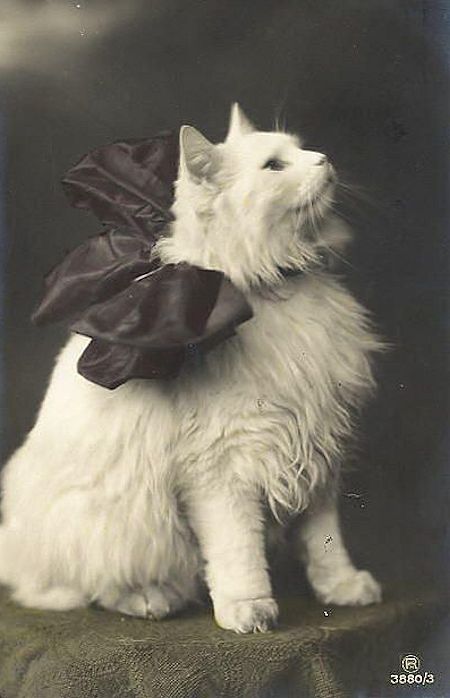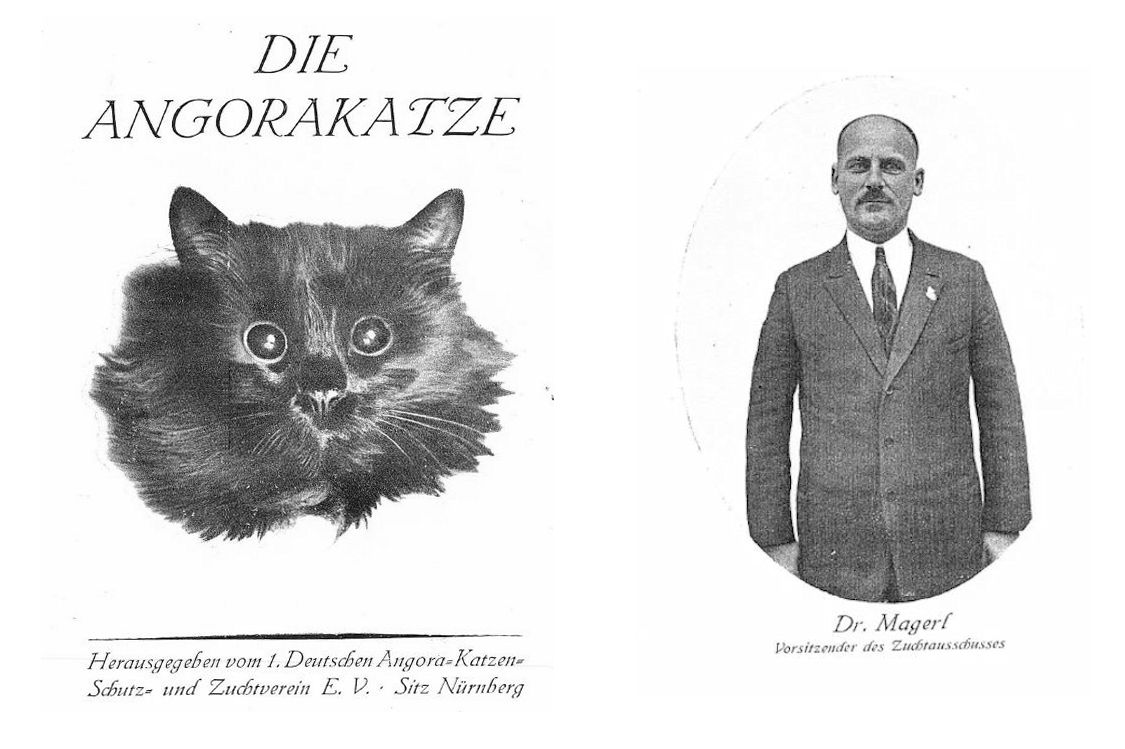
ANGORA CATS [LONGHAIR CATS]
BREEDING, CARE AND DISEASES, GERMAN STANDARD AND PATTERN DESCRIPTION
Published by the 1st German Angora-Cat Protection and Breeding Association E. V. Registered office in Nuremberg, under the kind assistance of Hrn. Dr.Magerl
1st edition January 1927
Publisher of the 1st German Angora-Cat Protection and Breeding Association, registered office in Nuremberg / print: Book printer Fritz Osterchrist, Nuremberg
1927: Reproduction, even of individual sections, is prohibited. All rights, in particular the right to translate into foreign languages, are reserved. [2017 Note: this has expired]

TABLE OF CONTENTS
Preface (Dr. Magerl)
General Information about Cats
Angora Cats [Longhair Cats]
Breed Description and Standard
Care and Maintenance of Angora Cats
Activity and Play for Angora Cats
Diseases
On the Choice of Sex and Castration
Angora Cat Kennels
Photographing the Angora Cat
Breed Association History
Conclusion
INTRODUCTION.
[Translator’s Note: at the time, the term “Angora“ meant “longhair cat,” rather than the Turkish Angora breed; the modern equivalents are the German Longhair and German Angora.]
There is little in writing about cat breeding and cat care in Germany and no attention has been paid to the care and cultivation of this ancient domestic pet. With the help of this book the Nuremberg office of the first German Angora Cats Protection and Breeding Association wants to arouse and promote an interest in breeding Angora cats. The Association has been active in this field for more than 5 years and has set down the experience of its members in the following pages. These are the results of lengthy years of passionate and systematic breeding work. By organizing the Angora Cats Protection and Breeding Association, by setting up a breed council, through rules and regulations and by establishing a breed standard, the Angora cat breed was given a firm foundation.
On this basis the consolidation of the breed can always be improved. We know that what we have today is by no means perfect. The time and effort of many breeders will still be needed until the knowledge and practice of Angora cat breeders reaches the same standard as that of other breeds. We hope and wish that this book of the First German Angora Cats Protection and Breeding Association E.V. Headquarters, Nuremberg, the headquarters of friends and sponsors of Angora cats, can unite and improve this noble race. - Dr.Magerl
ABOUT CATS.
Our house cat is a very old household companion. For several thousand years before Christ's birth, the Egyptians cherished and worshipped them, venerating them as sacred, talismanic animals. Even today, cats are highly respected among Muslims. The cat was unknown to the ancient Romans and Greeks as a pet. In Germany the domestic cat remained into the 8th century and was still rare in the 14th century. Over the course of time she has accompanied man almost everywhere, but has not become a servant to him as completely as the dog. The feline character is much more individual: proud, and more freedom-loving than that of the dog. When the cat is treated appropriately, it becomes at least as attached as the dog to its owner. The cat differs favourable from the dog by its distinct tendency towards cleanliness. They are intelligent and have sharp senses. Their physique is regularly shaped, and their movements extremely agile and elegant. A well-behaved and well-kept cat is an attractive asset to the house by its pretty appearance and beautifully coloured fur. She is a dear companion to her owner, because of her friendly, independent, affectionate nature.
We must not overlook the usefulness of a competent house-cat and mouser. We must reiterate that the cat is more difficult to treat and educate than the dog. She has a very different nature from that of the dog, and demands a kind and understanding hand. If treated cruelly or unjustly, she renounces human friendship and, true to her predatory nature, becomes a wanderer, roaming in open fields, in dark courtyards, on wide roofs, hunting birds, rabbits and chicks. This is why the cat is often described as an evil, untrustworthy, rapacious and harmful animal.
ANGORA CATS [LONGHAIR CATS]
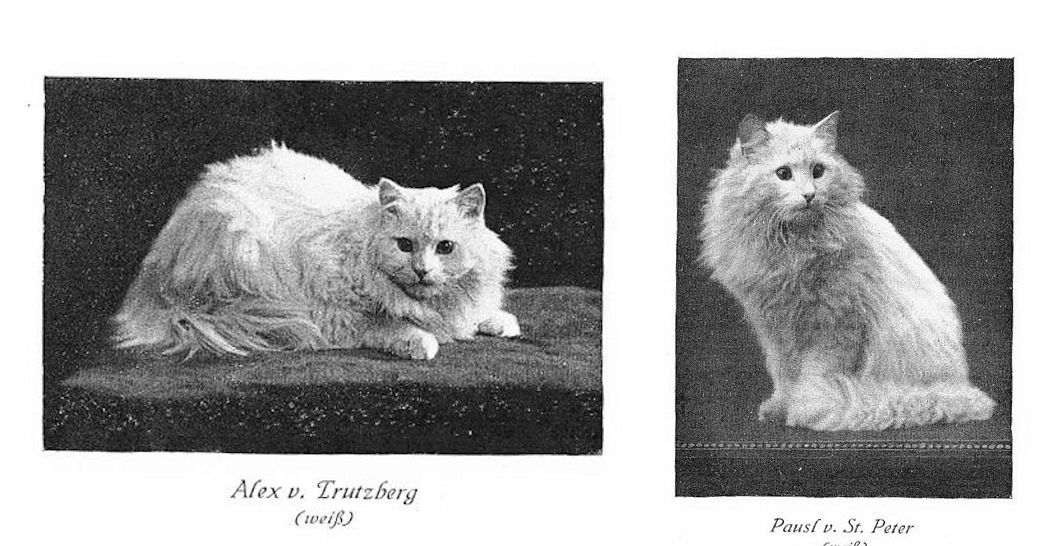
The question of the origin of the Angora cat is open to controversy and has not been fully resolved. Their origins have been ascribed to almost all continents. In the end, however, it is not the purpose of this booklet to determine its origins and we leave this matter to the research of other naturalists. In any case, we have in our Angora cat an animal which far surpasses the advantages of our ordinary domestic cat, and deserves to be foremost among domestic animals. In appearance, the Angora is a large, powerful, well-shaped cat. Her beautiful hair is long and silky smooth, and sometimes reaches 10-15 cm in length. She has bushy knickerbockers, a full mane, and an extravagantly full-haired brush (tail). Her head is small in proportion to her body. Her eyes are large and crystal clear. She has relatively small ears, tufted inside with long, plumy hair. The colour of the lips and soles of the feet depends on the overall colour of the animal. In the male, we are struck by the particularly full ruff which gives it a lion-like appearance. The wonderfully bushy tail, found in males and females alike, is carried proudly horizontal by the animals. It is usually only when they are in high spirits that they straighten their brush upwards in a defiant flourish, and it is a pleasing sight in its bushiness. The rest of the physique is wonderfully even; the limbs and body parts are in a harmonious relationship; the movements are so graceful grace and skillful that one is tempted to believe that the cat is missing some bones.
Their physical agility is combined with great intelligence and spirit. Their agility is important for jumping or falling; a cat almost always falls on her feet, even if she falls upon an object which is springy or unbalanced. This can be explained by the fact that she has wonderful control of her tail; if she is suddenly lifted off the ground by a hand, you will observe that her tail turns round its axis.
Cats have a great inclination for cleanliness. For much of the day, they find it necessary to wash and polish, smooth and straighen, so that no dust is attached to the silk-like fur. A lovely picture, and always a cat lover's favorite, is that of a cat washing its face. She does not tire of wetting her paw like a sponge and wiping her face with it. It is almost as though she cannot reach the end, as she always finds a spot that has not yet been cleaned to her satisfaction.
Just as the cat loves cleanliness in herself, she also likes clean surroundings. She demonstrates this when she seeks her litterbox, does her business, and afterwards buries her waste. An Angora cat, who is accustomed to her owner, loses the urge to go outside. Instead, and contrary to her usual habit of independence, she anxiously clings to her owner whenever she is carried into the open. Her anxious expression and fast-beating heart clearly reflect her agitation. She does not breathe easily until she is happy again at her apartment door. For this reason the damage caused by an ordinary domestic cat while wandering in yards, gardens, fields, meadows, and forests, and destroying birds, rabbits, chicks, and young hares, is entirely absent in the Angora. If kept in a home where there are no mice she brings no material benefit, but it is a great ornament, especially as she does no harm at all. She brings a lot of joy and fun to the home.
It is with the utmost injustice that people claim cats have no feeling of attachment. It has been proved that a cat treated with love and reason can become very attached to her owner. These lines, from a treatise entitled, "From a Diary," may strike a chord with some readers:
“From the first moment, 13 long years ago, my companion and I were together. Missing you is bitterly painful! Your tenderness, your pensive gaze, and even your soft purr, which told me that you were content. How did you know how to warm, radiate comfort and to rule me, my little tyrant, by your love which you gave only to me!
“He went from me as beautiful as he had come; full of love and gratitude to the end. Yes, when the last illness temporarily abated, he gave an answer - quiet, ever quieter - to my gentle stroking. So touching was this dying, as if he would comfort me even in his death, as if he said, ‘You are crying for me, forgive me!’
“I ask what would the earth be without animals? She would be barren and empty! They are the givers, we are mostly deeply in their debt! And how little we do in giving them our best care! Our little companions unfortunately have only a short life of joy and good fortune for us, and the only time they offend us is when they die. "
While the Angora cat does not subject herself to man unconditionally, this does not mean she lacks fidelity. Who would argue that an Angora cat raised from kittenhood with love and goodness is not touchingly grateful and faithful to her owner? In her innermost essence, however, she is a reserved aristocrat whose love cannot be won by force. She is not as passionately demonstrative as the dog, which is especially expressive through its whimpering, but on the other hand she is more subtle and tender.
One very controversial topic is "The Faithlessness of Cats." Fortunately, this completely unjustified prejudice can be cleared up. In her own home, the Angora does not tolerate intruders and even attacks the biggest dogs, and almost always wins. It is only after prolonged invesgtigation, when she has assured herself of the harmlessness and good-naturedness of her new comrade (whether it be a dog or a second cat), that her reticence turns to friendliness. It is different when they are introduced at a young age, when the most frequent animal friendships take place, such as those between cats and dogs, rats, mice and birds.
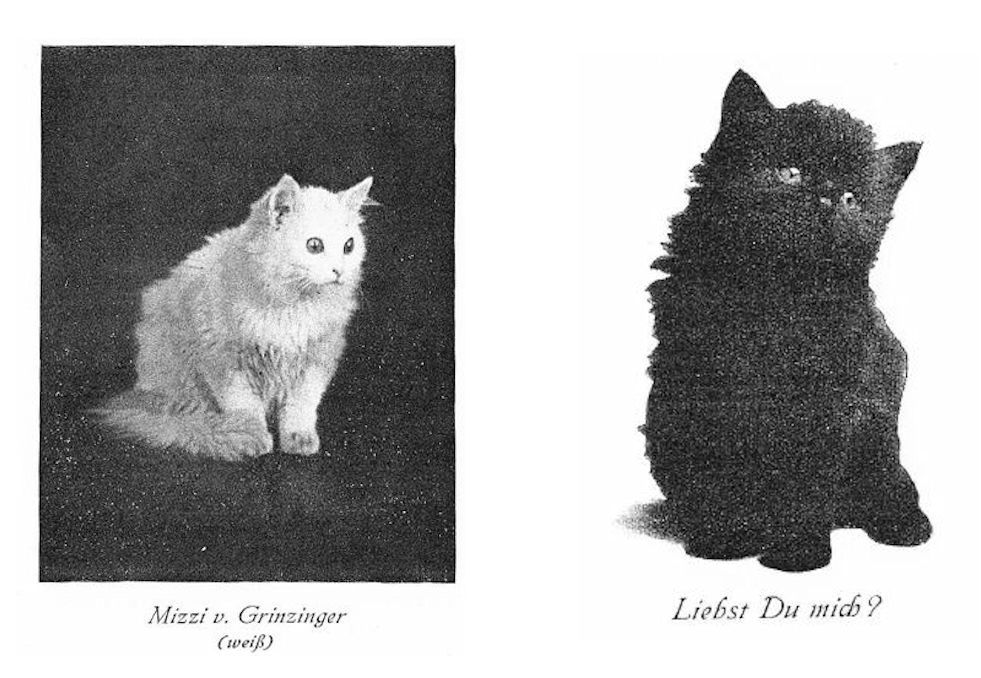
If an Angora is expecting kittens, she usually looks for a dark, protected place. She is an exemplary mother to her young, who emerge from the nest between the 9th to 13th day. With weary patience she tends and cherishes her babies. She, who normally jumps happily and unbound from one room to another, can remain motionless, often in a rather uncomfortable position, for hours at a time. It is only for food or to use the litterbox that she leaves her nest. If, however, a kitten blindly and carelessly leaves the nest and begins to scream, the anxious mother is immediately at hand! She carefully pulls it back into the nest amidst the rest of the kittens. During motherhood, she proudly sees to her family’s cleanliness and never tires of licking and cleaning their fur. Later, when they have opened their eyes, she speaks to them in a voice which is so completely different from usual. She speaks softly and tenderly to them and they gradually listen to her more and more, and soon obey their mother.
It does not take long before the cumbersome hobbling things become funny, playful, lively kittens. For the time being, their ever-present mother is quite sufficient as their plaything. How wonderfully they play with Mama's tail-tip, and even more wonderfully they ride on her back and hang onto her ears! Through all of this, mama cat maintains her admirable calm endurance.
Many people are unaware that, with patience, an Angora cat can be taught several tricks. There are cats that can jump up to 1.50m, fetch balls of paper and other things, shake paws and sit up and beg. Only a poorly trained cat climbs the window curtains and jumps onto the table at mealtimes. However, you should not tolerate the stealing. Many Angoras will leave your food in the kitchen untouched, but there are exceptions. Lack of training demonstrates that the cat takes what it can get. When she is caught, she has the insolence to clean her mouth with an air of innocence, looking as though she wants to say, "Why do you leave good things out when you know that I cannot resist stealing them?"
The Angora has a peculiar ability to remember times with punctuality, almost as it if carries a schedule. We know of cats who expect their owner to emerge from the bedroom door every morning. If the owner is late leaving the bedroom, the cat expresses her impatience by screeching at the door. They also demand their food punctually every day, and even notice which days they get raw meat. Noises, such as knife-blades, eggs breaking, and cooking pans, have an effect on the Angora at any time of the day. Of course, they are hoping for a treat, but it is nevertheless remarkable how sharply the cat notes such noises.
The resilience of an Angora cat is amazing. A case that came to our attention illustrates this. When the old regional public health institute in Nuremberg moved to a new building, a white Angora cat was accidentally locked in a cellar. In vain the owner searched for his cat and he came to the conclusion that his favorite had been stolen. He was shocked, when, after three weeks, it turned up in a skeletal, semi-starved state. Unfortunately, it succumbed to the effects of starvation in spite of medical attention. It was subsequently discovered that it had escaped from the cellar rooms when they had had been reopened to retreive files left behind in the old building. It had survived three weeks without eating.
Another case was reported to us, where an Angora kitten was sent from Nuremberg to Ansbach. There is no way to describe the owner’s astonishment when it suddenly reappeared after eight days. It had taken that time to find its own way back to him. In any case, the examples given here demonstrate incredible resilience and resourcefulness.
In addition it should be mentioned that the Angora, which is not difficult to breed, offers an interesting field of activity for the breeder, in particular colour-breeding, as well as the perfection of other visible pure breed characteristics. In order to guide breeding along consistent lines, the 1st German Angora Cats Protections and Breeding Association located at Nuremberg provides the following descriptive breed standard.
CONFORMATION
The Angora cat is a large, elongated, but sturdy cat with a lion-like appearance. The long hair is the main feature of all the colour varieties. This is particularly pronounced on the neck, as if forming a mane or neck ruff. This also covers the front half of the body and is especially pronounced in the male animals. The hind legs are long-haired to the hock, forming the so-called knickerbockers. The bushy tail gives the Angora cat a special character. There are tufts of hair in the ears and between the toes. The head is short, the ears small, barely protruding above the fur, and set wide apart, giving the impression of a broad forehead. The eyes are large and round, the nose wide and snub.
The eye colour is related to the overall colour of the animal as described below. The whole body of the animal shows balanced dimensions. The back must form a line which is as horizontal as possible, not sloping noticeably forward or backwards. The richly furred tail should mark a continuation of the spine. It is of medium length and must not be carried rolled, but in a straight line.
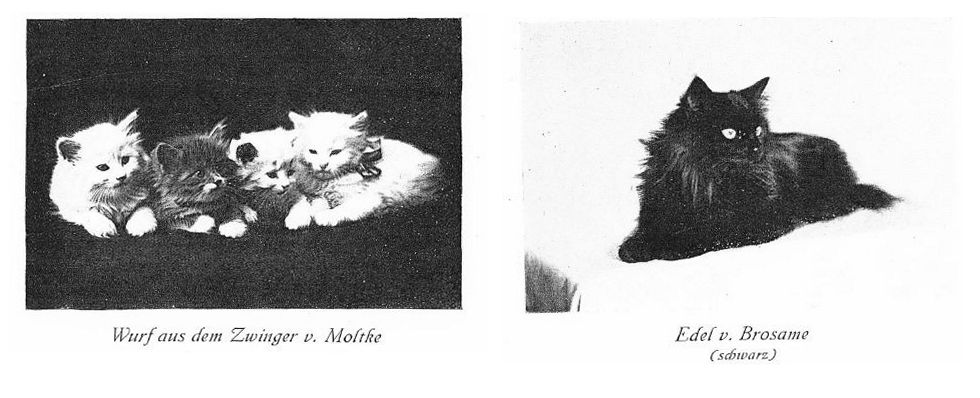
COLOUR CATEGORIES
1. WHITE:
In this colour category, the main condition is that the fur is pure white without any markings or yellowish tint. The head is round, the nose wide and blunt. The ears should be set as far apart as possible, thus giving a wide forehead. The outside of the ears should be well-haired, so that the hue of the rest of the body is not interrupted. At the tips of the ears are tufts which protrude beyond the end of the ears. The fur should be quite long, and silky soft on the whole body. The eyes can be blue (the darker the better), amber yellow or sea green, the animals with different coloured eyes are also found. Paw-pads, nose-leather and mouth should have a rosy-pink colouring without any milkiness (mixing).
Scale of Points:
Colour 15; Fur 20; Head 15; Eyes 10; Mane 10; Tail 10; Conformation and Condition 20
Total: 100
2. BLACK:
Fur and body shape sames as the whites. The colour should be pure black, rich without any rusty tint, and as dark as possible. Cats in this class must have the same colour throughout the body, with no other markings. Isolated white guard hairs are allowed. Paw-pads as well as nose-leather are black, eye colour is golden yellow.
Colour 15; Fur 20; Head 15; Eyes 10; Mane 10; Tail 10; Conformation and Condition 20
Total: 100
3. BLUE:
Blue is probably one of the best-established colours. The name "Persian" is often used for blues, but in reality these are not a different race as, in Germany, the term "Angora", is not only used for the longhaired cat, but also for rabbits and guinea pigs, while in England the term "Persian" applies to all long-haired cats of any colour. Fur and body shape is the same as for the white. The colour should be pure blue. Light or dark shades are both allowable as long as the tint is consistent throughout the body and does not show any darker or brighter parts. Some white markings, however small, will cause disqualification. The eye colour should be golden yellow, the paw-pads and nose leather should be dark. The claws are horn-coloured (ivory coloured).
Colour 15; Fur 20; Head 15; Eyes 10; Mane 10; Tail 10; Conformation and Condition 20
Total: 100
4. TABBY
This designation requires clarification to show what is meant by "tabby". There are three colour classes in tabby cats: gray [brown/black], silver, and red striped. In the latter, the stripes are not black, as in the first two, but are a darker red than the base colour. The silver has a grey base colour with black stripes, The grey has a grey-brown base colour with black stripes. The stripes should be pure-coloured, profound black in grey and silver-tabbies, rich red in the red-tabby.
Animals in this class are not allowed any white markings. The stripes must be distributed throughout the body. Beginning with the head, there should be an "M" on the forehead above the eyes and 2-3 fine lines should run over the cheeks. Between the ears, the end-lines of the M-mark must continue along the whole back, from narrow lines at the nape of the neck, which widen at the middle of the back and then narrow again. The tail must have several dark rings around it. Rear of the abdomen, the stripes should form a circle [bull’s eye]. Above the breast there must be clean lines which continue down to the paws, tapering more and more. The same applies to the hind legs. In the gray-tabby [brown/black tabby], both darker or brighter basic colours are permitted. The striping should be well defined. The paw-pads should be dark and the claws ivory. The nose-leather of the red-tabby must be flesh-coloured, in the others it is a darker version of the same colour. The eyes are sea-green in the case of the silver-tabby, gray-green or golden-yellow in the gray [brown/black] tabby and golden-yellow in the red tabby.
Markings 20; Fur 20; Head 10; Eyes 10; Mane 10; Tail 10; Conformation and Condition 20
Total: 100
5. TIGER-MARKED (Wild-coloured):
This is closely related to the tabby and is found in the same colours as the tabby, but with the difference that the tiger-marked cat is covered with very narrow black or red stripes which do not form circles at the sides of the belly, but form long, straight, vertical lines on the body. In the case of short-haired cats, this pattern is often quite pronounced, but we rarely find it so clearly marked in our long-haired cats. Due to their long fur, the narrow stripes appear to be somewhat fuzzy and thus the whole looks rather blurred. A tiger-striped Angora only shows its markings well in the summer, when its fur is thinner and shorter. The term "wild colour" is often used for this pattern. There should be clear lines on the head. In other respects, the same conditions apply to the tiger striped as to the tabby cats and the standard of points is the same as the tabby.
6. CHINCHILLA CATS:
These must have a silver colour distributed uniformly over the whole body, without no sign of streaks, a pattern which places great demands on the breeder. There must be special attention to dark-pointed “guard hairs” protruding among the rest of the coat, these are isolated standing hairs with black-brown tips, which greatly enhance the colour. Sea green eyes complete the impression of a good animal.
Colour 20; Fur 20; Head 15; Eyes 15; Mane 10; Tail 10; Conformation and Condition 10
Total: 100
7. SMOKE CATS (SILVER-MOOR CATS)
This variety, still very rare in Germany, deserves special attention, since this pattern is rarely seen in any other animals. The basic colour, except for the head part and legs, which have a deep black to the paws, is silver-coloured, the surface of the hair being black, as though smoke-blackened. The epitome of the smoke cat is probably a pitch-black head, surrounded by a silvery-haired frill or ruff. In the case of the ruff, only the very tips of the hairs show black colouring, and thus the hair shows the silvery base colour. On the rest of the body the basic colour only appears weaker because almost half of each hair is black coloured. Round, golden yellow eyes give the black face a distinctive expression. Claws and paw-pads are dark.
Markings and basic colour 30; Fur 15; Head 15; Eyes 10; Mane 10; Tail 10; Conformation and Condition 10
Total: 100
8. TORTOISESHELL-AND-WHITE [LUCKY CATS]:
Special attention is paid to this class. Who would argue that such a distinctive animal, whatever its pattern, could not please the eye of a cat lover? The queen among these is rightly referred to as the three-coloured or lucky cat. The pattern of white, black and red gives this animal a special character. The main condition is that apart from the three colours mentioned, there are no gray marks. The white main colour is covered by a blanket consisting of black and red spots, which extends from the upper half of the face over the neck, the entire back, and the sides to the tip of the tail. A symmetrical pattern which is uniform on both sides increases the pleasing effect. The alternating black and red patches should be well delimited with no white spots between them. Eye colour is golden yellow, nose-leather and paw-pads are flesh-coloured.
Markings 25; Fur 15; Head 15; Eyes 10; Mane 10; Tail 10; Conformation and Condition 15
Total: 100
9. FIRE CATS [RED, YELLOW CATS]
a) Red:
In contrast to the red-tabbies, any sign of tabby markings must be avoided. A rust-red colour, distributed evenly over the whole body, is required. The colour of the nose-leather and paw-pads is fleshy; the eyes are golden.
b) Yellow
Like the red, the body fur must have a uniform, medium-yellow colour. Everything else is as for the Red.
Colour 20; Fur 20; Head 20; Eyes 10; Mane 10; Tail 10; Conformation and Condition 10
Total: 100
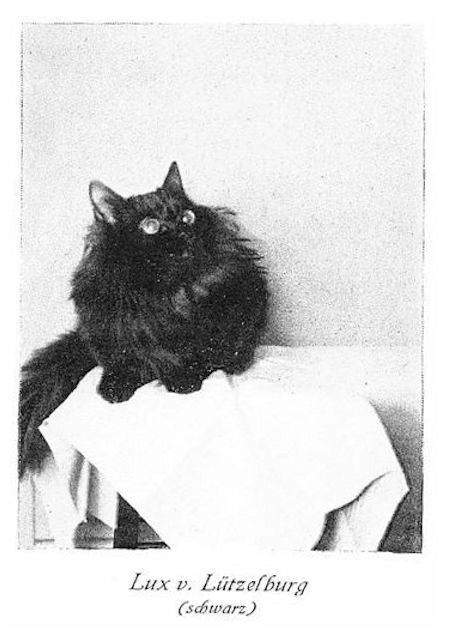
10. ANY OTHER PATTERN
This class is for all colours and patterns for which no individual class is listed. It includes those which are predominantly one colour, such as black, blue, brindle, etc., but which have some trait, such as a white star on the chest, white paws, or a black spot on the white main colour, and the like. Here, more than in any other class, it is up to the judge to decide, since it would be impossible to set down all the individual colours and their variations. The markings around the eyes deserve attention here. These should be symmetrical i.e. cover both sides of the face. Different amounts of markings are to be evaluated together. All colours are allowed. Eye colour differs depending on the main body colour.
Markings 30; Fur 15; Head 15; Eyes 10; Mane 10; Tail 10; Conformation and Condition 10
Total: 100
Animals with bow legs (O-legs), knock-knees (X-legs) or too wide legs are worthless for breeding. Also the complete existence of the whiskers must be taken into account during the evaluation. Penalties also result from inadequate care, matted fur, dirty body parts, etc. When a sample description is drawn up, of course, only ideals of animals must be kept in mind; Since however the breeding of our Angoras in Germany is still young and is not at the desired height, the sample description should encourage the breeders to get as close as possible to the aspiring goals. According to these points of view therefore, in an exhibition those animals that most closely meet the standard are awarded the highest prizes. Excluded from prizes at exhibitions are animals with obvious illnesses, such as sore or bald spots, ear-canker, mange, rashes as well as other eye-catching defects of individual parts of the body. Also excluded are animals that do not achieve more than half of the maximum score for fur, colour or conformation.
CARE AND MAINTENANCE OF ANGORA CATS.
For the protection of the Angora cat, of course, we must also discuss their. First and foremost, it must be accustomed from a young age to using a box for carrying out the call of nature. This generally consists of a wood or sheet metal tray filled with sawdust, ash, sand or peat crumbs. Its contents are best emptied and renewed daily. Recently, improved boxes with water drainage have been introduced on the market from almost all sides. The principle here is as follows: A tin box with a perforated bottom is placed within a second box, whose bottom is filled with water to which 10 drops of Lysol are added. This box (we especially recommend Schmidt's ideal box) can either be ordered ready-made, or can also easily be made by any plumber using the sketch provided (Fig. 1). It has the advantage that the urine leaks through the perforated holes and becomes odorless in the water. Even the most hard-to-housetrain animals can easily be trained to cleanliness by this facility.
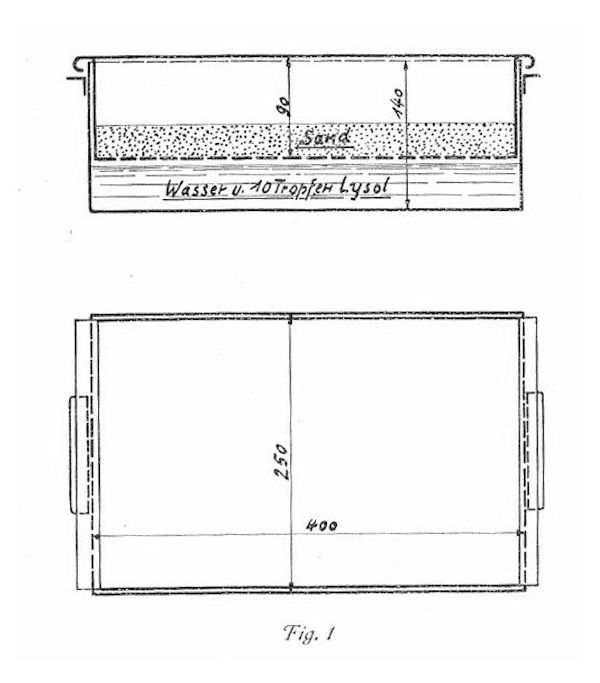
Special attention should be given to the sleeping place of our Angora cats. Make sure that the underlay is soft and clean and is installed in a completely draft-free location. The cats require a cardboard box, not much larger than themselves, for sleeping so that they are well enclosed from each side. For the sake of cleanliness, the blankets or cloths used as bedding must be frequently changed so they do not become a breeding ground for insect vermin.
Their food generally consists of cubes, which are soaked in milk, of horsemeat or other cheap meat (Freibankfleisch) which is best cooked with rolled oats, semolina or rice. The meat must be minced only after cooking. Even when raw and in small-scale amounts, meat is often sufficient for the animals. Vegetables such as spinach, beans, yellow beets and soup vegetables contribute greatly to the growth of the body, and from time to time are indispensable to Angora cats. Spratt's cat food, which also contains important nutrients, is also recommended for the animals. As a preventive agent against diseases, from time to time give raw ox spinal cord [oxtail] as the bone-marrow cleanses the stomach.
[Translator’s Note: Freibankfleisch. A Freibank was an “isolation slaughterhouse” selling meat classified as "conditionally suitable for consumption" by meat inspectors. Freibankfleisch is flesh from animals that were not bred for their meat e.g. ones slaughtered due to injury or illness. These were generally younger animals, not old ones. The animals and meat underwent more thorough veterinary medical tests than those from standard abattoirs. This made it possible to acquire good quality meat at a minimal price. This practice went back to the Middle Ages.]
To satisfy its thirst, the cat needs slightly warmed milk, either pre-boiled or uncooked but always very fresh. If milk is not tolerated by the cat, as indicated by diarrhoea, water can be given instead. The latter is often required by the cat and should, therefore, always be available in a small dish; the milk can also be cooked with 1/8 water. Food should be served at regular intervals, in the morning, at noon and in the evening. After each meal, remove the leftoivers and scrub the bowls. Irregular feeding, or ingestion of spoiled food are often causes of disease.
It is an unconditional duty for every cat lover to set up a flower pot in a corner of the kitchen or a flowering plant with grasses. Both old and young cats like to eat the grass. Grass is indigestible and is regurgitated by the animal after a short time, thus cleaning the stomach.
During her gestation period, the mother animal must be given plenty of raw meat.
Another part of cat care is daily combing and brushing, so that the long hair coat does not become matted. At least once a month bathe the cat. At first she will try by all possible means to escape her fate, and will use her main defence - the claws. It is recommended that the owner make four small cloths for the cat, which are pulled over her paws before bathing her. The bath room must be well heated and the water hand warm.
For washing, use the well-known "Junka animal soap". After moistening the whole coat sufficiently, rub in the soap thoroughly to form a rich foam. Leave the animal in that condition for 5 minutes so that all the insect vermin is killed. Then rinse off the soap and rub the coat dry with a towel. A warm spot by the stove, or even better, an electric hair dryer will quickly dry the coat. Of course, one must take care that the animal does not get cold. Many cats like their face washed daily with a damp sponge.
Care of kittens requires great attention. In the first four weeks, they live entirely on their mother's milk, and later they can be suckled on sugared milk, which can be mixes with an egg, by means of small rubber teats. It is only by degrees that they become accustomed to independent eating. Their food should then consist mainly of finely chopped meat.
Kittens are blind until the 10th, 12th, even 13th day. If they cannot open their eyes, one can help by wetting a soft sponge with lukewarm milk and brushing it over the eyes. If this repeated frequently during the day, the difficult business of opening the eyes is made much easier for the kitten.
Now some notes are required about mating behaviour [rolling] in the Angora female. This is signalled by the fact that her voice and behaviour change. At this time she often rolls on the floor, and sometimes screams and continually treads with her hind legs. This is the appropriate time for the breeder to take his animal, which must be at least one year old, to be mated. The behaviour is a sign that she is ready to be mated. The male and female are usually together for 1 day and are then separated again. The pregnancy period is 60-65 days. Shortly before the end of this time, she is continually searching for a dark spot. If a box or baskets with blankets are laid out in a hidden place, she will gladly use them. During the birth, she can usually be left to itself, and human help is rarely necessary. The litter consists of 1-6 young. As previously mentioned, pay special attention to fortifying food for the mother. In particular, she will require more lukewarm milk than usual and a lot of raw meat.
Punishment of the cat must not consist of a beating, a well-fitting smack is sufficient, if absolutely necessary. In general, however, one can achieve a lot more with a cat, if it is verbally rebuked when caught in the act. This has a much more lasting effect than any beating, because the latter might make the animal shy and stubborn. Despite the need for punishment, one does not want her to lose confidence in her owner.
ACTIVITY AND PLAY FOR ANGORA CATS
It is wrongly claimed that Angora cats are lazy and need to be carried about. This is only true if the animal is not given stimulation. It is, therefore, important to provide toys for our Angoras. The simplest toy is probably the plastic ball, which, however, has the great disadvantage that it usually disappears under the cabinet or piano and is then inaccessible to the cat. For this reason the attentive observer provides a paper ball which the cat likes to use as a toy. With great joy, the young kittens grab this toy with their teeth, jumping on the table, chair or even on the cupboard, to drop it from the top. This small makeshift item is probably one of the best toys. An entertaining activity is a cloth ball hanging on a rubber band, which is suspended from the door latch or from a nail on the wall. As the ball rises upwards, when the animal has been attacking it, the cat is given the opportunity to practice jumping.
In any case, the cat lover is recommended to teach his cats to jump. This is best done with a cane, while a second person lures the cat with a treat. To reach the treat she must jump over the cane. This unusual action will soon become a habit, and with time one can reach quite a considerable jumping height.
Another type of activity, which also corresponds to the caat’s natural urge, is climbing. For this purpose, one of our gentlemen has made a climbing tree, which we describe in the following:
The climbing tree (Fig. 2) consists of a paper roll of 80-100 mm diameter and about 1000 mm length (a). At the bottom this tube is fastened by two opposing nails ( e) to a strip of wood ( b). After this, a square of 350 mm of side length (c) is sawn out of an old crate cover and attached to two batons (d) of approximately 10 mm in height and 20 mm in width which give the base (c) better stability. Now, with the wood screw (f), the base (c) is fixed onto the wooden strip (b) which is fixed inside the base of the cardboard roll (a). The cardboard roll is now covered in an old sack-like fabric stitched together, and the climbing tree which our little pets so gladly use is ready.
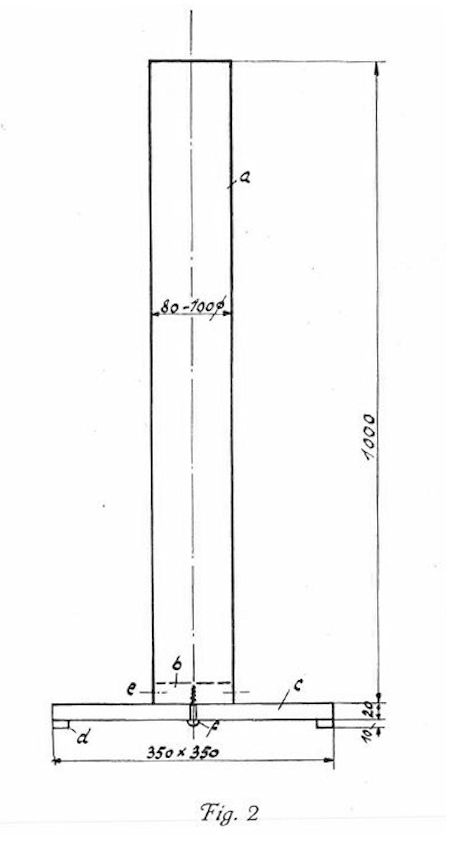
It is well known that our favorite pets often damage upholstered furniture, bedcovers, curtains, etc., by sharpening their claws. But this problem can be controlled by attaching a floor-mat, a straw-cover, or a piece of burlap or sackcloth to a board and attaching this to the wall in a suitable place. When the cat is about to sharpen her claws, is led to the board and one scratches her paw against the fabric. Since cats are curious, clever, and docile, they usually take the opportunity to dig their claws into the board and scratch them down on the first attempt. If the cat again tries to scratch the furniture, it should be guided with vigorous admonition to the designated place.
The Angora cat can also be trained to perform tricks, such as sitting up and begging, and to retrieve objects. Of course, all of this takes a great measure of perseverance, love, and patience. It is to be noted that lessons should take place at certain hours of the day and may not exceed half an hour.
If sufficient stimulation is provided, you will be able to establish that they spend much of the day active, which will be beneficial to their health.
ON DISEASES AND THEIR TREATMENT IN CATS.
GENERAL.
The domestic cat is treated by the veterinarian more rarely than the dog. The reason is that the cat is less favoured by man than the dog. People are more inclined to pay for treatment for even a worthless dog than for a cat. The second reason is the worthlessness of the ordinary domestic cat, but reason fails when it comes to pure-bred, valuable cats, such as the Angora and other breeds. The cat is more worldly, more nimble and more cautious than the dog, and less likely to be hit by cars, carriages, etc.. Falls from a moderate height usually do not harm her, nor is she as aggressive as the dog so she is less likely to get bite injuries.
SPECIAL FEATURES OF THE CAT.
The internal structure of the cat is generally similar to that of the dog. The cat has a similar simple meat-eating stomach and its internal organs resemble those of the dog. We find in the cat, albeit more rarely, the same diseases as in the dog. But it has certain oddities compared to the dog. For one thing, she is not a fan of taking medicine. It is often difficult to give dogs herbal remedies, but it is much more difficult, and often impossible, to medicate a cat. Their self-sufficiency and their ability to fight with "hands" and "feet" often prevent the best cures.
In particular, it has a strong antipathy to alcoholic (ethereal) remedies and to strong smelling remedies, which are particularly difficult to administer. One usually requires a great deal of patience and calm. Liquid cures must be slowly introduced into the mouth with a small spoon. Powdered medicine can be mixed with finely chopped meat or sausage, or according to taste with sugar and honey. By friendly persuasion, rather than force, it is possible to administer medicine to a cat. If one must use force, the cat can be made defenceless by wrapping it in thick cloth so that only the head is exposed. Otherwise, restraining a cat requires 3 people: one to hold the scruff of its neck, the second to hold the forefeet, and the third to restrain the hindfeet. To hold on to the scruff of the neck is a task for a strong and fearless person, who is not afraid of angry hissing.
Another special feature of cat treatment is that it is risky to anaesthetise a cat for major operations. While nowadays long surgical operations can be carried out on dogs under anaesthesia, this is almost impossible with cats, since general anaesthesia produces life-threatening conditions in cats. Additionally, the cat has very sensitive belly skin. Abdominal operations are frequently fatal due to wound inflammation. Cats are very susceptible to carbolic acid and similar disinfectants; application of carbolic acid and lysol may result in the death of the cat if one is ignorant of this fact. She is also averse to water treatment, so this method of treatment is also unsuitable.
The cat’s skin is even more mobile than the dog's. As a result, dressings are more of a problem in the cat than in the dog, because of dexterity and flexibility of their bodies means they can easily get rid of uncomfortable dressings. Where wounds are smeared or brushed with remedies, cats usually remove the medication with great perseverance and thoroughness with their rough tongue.
Therapeutic treatment is therefore limited in the cat. It is best that the owner treats his cat, as he can usually give her remedies and other treatment that she would furiously oppose from a stranger. Cats are also more individual than the dog, and each cat is different. They show such strong differences in their appetite, activity and behavior that the owner is best placed to recognize the early signs of illness.
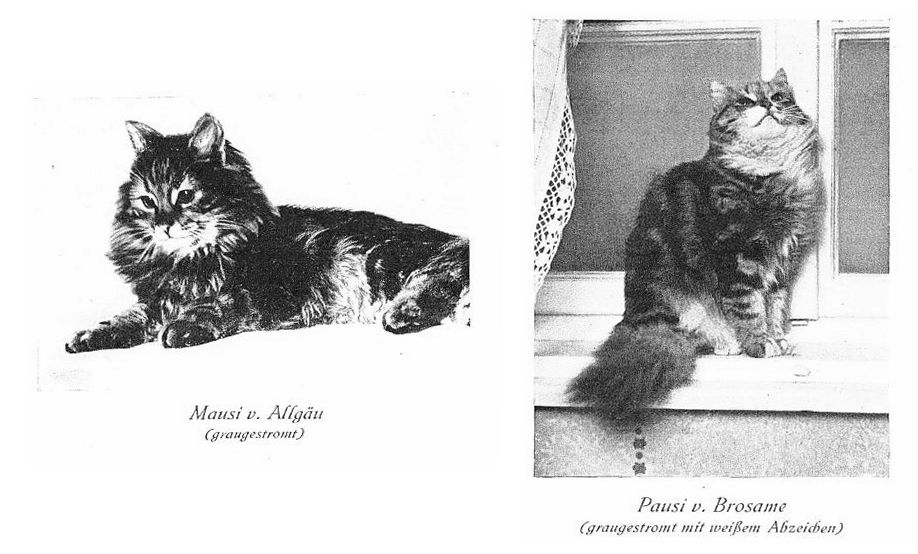
GENERAL SIGNS OF HEALTH ARE:
Good appetite; lively, rapid, agile movements; dense, shining, soft fur; moist nose, pink mucous membranes; purring and keeping clean. The pulse rate in healthy cats is 110-130 per minute; the number of breaths is 20-30 per minute; the body temperature is between 38 and 39 celsius.
DISCUSSION OF THE MOST IMPORTANT DISEASES:
FELINE DISTEMPER.
Some of the cat diseases are not yet fully understood because the economic worthlessness of cats has prevented expensive and time-consuming investigations. Among these illnesses are the so-called Cat Plague [Katzenseuch] and Cat Distemper [Katzenstaupe]. The first disease is a vomiting disease where foamy mucus, often yellow or greenish-coloured, is vomited several times a day. The cat is depressed, mostly sits quietly in a hunched posture and its fur is lifeless. It loses its appetite and usuallystopes eating completely. If something is ingested then vomiting occurs immediately. There is usually a strong thirst for water, while milk is declined. Sometimes this is accompanied by diarrhoea, but often the cat has constipation. Young animals often succumb to the disease very quickly (1-3 days). Older animals are more resistant, but even so the disease is often fatal. If the cat survives beyond 8 days of illness, experience shows that it will usually recover. In the post mortem dissection, one usually finds severe swelling of the liver and inflammation of the dorsal gut and other intestines.
This cat plague is often equated with dog distemper, but it only has similarities with that disease in terms of the gastro-intestinal tract. The other forms of the dog plague – eye distemper, distemper rash, and nervous distemper - are observed very rarely in the cat. It is, therefore, questionable whether cat distemper is truly comparable to dog distemper.
Treatment is difficult because the animals usually vomit immediately they ingest something. Therefore, only treatment by subcutaneous injections by the veterinarian holds any promise.
The cat must be kept warm, especially its belly. This is best ensured by placing a warm water flask in its bed, or by wrapping it in an electric heating pad, while warm peppermint tea is given to the cat to drink rather than water. At the beginning of the disease, it is advisable to give a laxative (a coffee- spoonful of castor oil) and lukewarm enemas to the rectum. Where the patient shows a long term improvement, proceed with feeding it, giving fortifying but easily digestible food.
The disease is easily transmissible through faeces and vomit. All these excretions must be carefully destroyed and the area disinfected. Healthy cats should be kept as far away as possible from sick cats.
RABIES
The cat prone to rabies the same as the dog. Cat rabies is especially dangerous to man, since the diseased cat jumps up and bites or scratches. The symptoms are similar to those of the dog. The cat is grumpy and irritable, her appetite disappears and her voice becomes peculiarly hoarse. The phenomenon of furious anger then appears, the cat escapes, bites, and scratches and fights humans and other animals. It succumbs to the disease faster than the dog (2-4 days), and symptoms of paralysis of the lower jaw and hind legs quickly occur. Sometimes this paralysis is the only sign of cat rabies. Cat rabies is notifiable, so if it it is suspected it must be reported to the local police. Bites and scratches from infected cats, or those suspected of infection, must be carefully expressed and washed out. Disinfecting them with of vinegar and citric acid is recommended. You should then seek a doctor at once.
TUBERCULOSIS.
Tuberculosis is not unusual in city cats. The symptoms are gradual emaciation, weakness, and harsh coughing. Tuberculosis of the lungs and kidneys are the most common forms in cats. It contracts tuberculosis from sick people. It is unlikely to recover and tuberculous cats are best destroyed. The formal diagnosis of tuberculosis is only possible by means of certain diagnostic vaccinations performed by the veterinarian.
DIPHTERIA.
This disease is rare. The tonsils become swollen and the throat inflamed. One sees yellow and grayish-yellow deposits on the tonsils and throat. The animals eats little or nothing, it salivates, becomes feverish and has a nasal discharge as well as swelling of the cheeks and the larynx. The treatment consists of quarantining the diseased animals, administering soft or liquid food, and by the veterinarian rinsing the mouth and brushing the tonsils.
GLANDERS [Literal Translation: SNOT]
Lions and tigers occasionally contract a blood disease as a result of eating glanders-infected horse-meat. The domestic cat can also suffer from glanders from eating infected meat. There is inflammation of the mucous membrane, the nose, the mouth, the larynx, and the airways become painful. There is a greenish-yellow, later bloody, discharge from the nose, and swelling of the lymph-glands in the throat, swelling of the nose, head and legs, and formation of boils and ulcers. Diarrhoea and emaciation ensues. Death occurs after about 8 - 14 days. It is unlikely to recover and animals suffering from glanders must be destroyed. Glanders is transmissible to humans, and like rabies it is a notifiable disease.
ANTHRAX.
Anthrax is transferred to the cat through feeding infected meat. This very severe disease is characterized by high fever, weakness, apathy and bloody diarrhoea. Death occurs very quickly in a half day to 2 days. Anthrax can be transferred to humans and is notifiable.
FOOT-AND-MOUTH DISEASE.
When given milk from foot–and-mouth-infected animals, the cat becomes ill with fever, vomiting and paralysis. Blisters and ulcers form in the mouth, on the tongue, and on the forehead. This disease is also subject to notification. Treatment is by the veterinarian. [Translator’s note: cats cannot contract foot-and-mouth disease]
MANGE.
The most common form of mange in the cat is that which occurs inside the ear, and is caused by a mite, which breeds massively in the ear. The animals shake their heads and hold them on one side. Crusts, scabs, and scales form inside the auditory canal, often so densely that the whole ear canal is blocked. The constant scratching and rubbing of the ear causes inflammation of the whole ear. Treatment consists of carefully cleaning the ear canal with plugs of cotton. After cleaning, equal quantities of glycerin and Peru-balsam are mixed and dropped into the ear. In more severe cases, consult the veterinarian. A second form of mange is the so-called sarcoptic mange caused by a burrowing mite. This usually also starts at on the ear pinna, the hairs are ruffled and fall out. Red dots, small blisters and scabs are visible on the skin. The cats suffer severe itching, and constantly scratch their ears with their paws and rub their heads. The dried-up blisters and pimples gradually spread and congeal into gray-yellow crusts. Mange can also be transferred to the paws and the rest of the body by the scraping and scratching. When it reaches the stage of spreading crusts, the animals are very much depleted and ultimately die from exhaustion. Treatment must be carried out by a veterinarian.
A third type of mange is that produced by the Akarus mite [flour mite]. This form is particularly dangerous and resistant. The nose, and the areas around the eyes and the ears are the most commonly affected. Small bluish pustules with purulent contents form in those regions. The hair is ruffled and falling out. A reliable diagnosis can easily be made by microscopic examinations. Treatment is the responsibility of the veterinarian.
In addition to these three forms, there are other skin diseases and eruptions that are caused by various vegetable fungi (Favus and herpes). It is often difficult to distinguish between these diseases, and the veterinarian must be consulted.
INTESTINAL WORMS.
Cats, especially the young animals, suffer greatly from intestinal worms.
These are a) tapeworms, b) roundworms, c) pallisadeworms [strongylid worms], d) stomach-worms.
The most common tapeworm (Taenia) is Taenia Crassikollis, whose larvae (cysts) live in field mice. The tapeworm often occurs as an epidemic in cats when they eat infected field mice. The symptoms of tapeworm infection are vague: alternating voracious appetite, emaciation, intestinal catarrh, listlessness, nervous convulsions and epileptic seizures. A sure sign is the discharge of yellow-blown tapeworm segment through the rectum. The tapeworm can be cleared by tapeworm treatment. Ttapeworm tablets from Reichert-Cannstatt, available from the chemist, are recommended.
Roundworms also occur frequently, often in thousands. The symptoms are: digestive upset, pot belly, emaciation, alternating diarrhoea and constipation, itching at the anus, and the surest sign is the discharge of thread-like roundworms. A home remedy for roundworms is garlic boiled in milk. If this is unsuccessful, you can get advice from a veterinarian.
The Pallisade worms (Dochmia) produce severe disease: severe diarrhoea, uncontrollable vomiting, increasing weakness and emaciation. The fur becomes shaggy, and there is purulent nasal discharge. The appetite usually remains good. The stomach worm (Ollulanus) of the cat is a strong, filiform worm that causes vomiting in the cat, and the worms are often vomited up. Treatment of pallisade worms and stomach worms is the responsibility of the veterinarian.
FLEAS AND LICE.
A well cared-for cat is rarely affected by these vermin. In thecase of fleas, Persian insect powder or juxin is effective. The fleas, however, are only stunned by this and bounce back to their old place when they recover. For proper treatment, the cat must therefore be dusted with the powder and put into a box or sack with only the head exposed. The fleas on the head can be sought out and destroyed. The cat must remain in the box or bag for about 10 minutes, then it is let out and the box or sack, containing the vermin, is burned. The cat’s bed must also be properly treated with insect powder.
This treatment may need to be repeated several times. The home must also be treated diligently, as fleas hide in any debris and rubbish of the rooms and repeatedly infest the cat. At the same time as the cat is treated, the rooms must be thoroughly cleaned and disinfected. Lice usually only occur in older animals. Frequent combing with a nit-comb is recommended. Further treatment of lice consists applying a wash of Sabadill vinegar 1 to 20 [Sabadilla, Louse-herb - Schoenocaulon officinale].
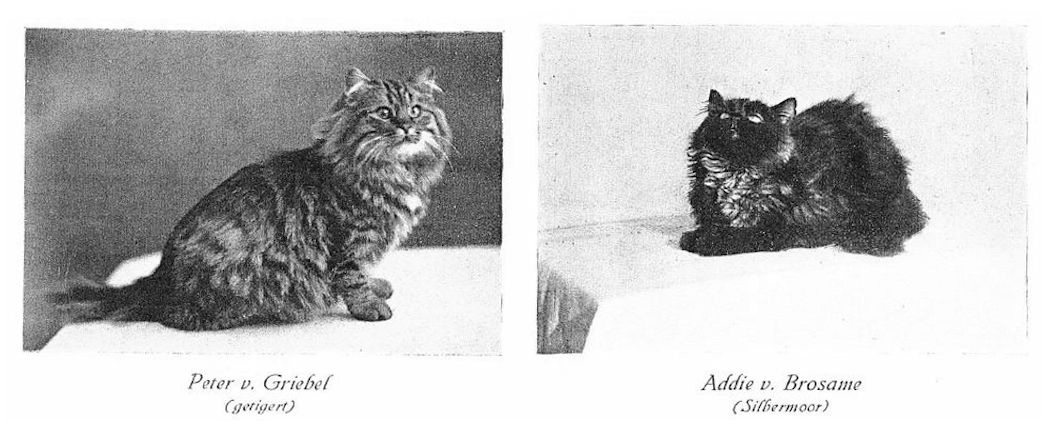
POISONING
The most serious cases of poisoning are phosphorus, arsenic, and strychnine. Phosphorus poisoning is characterized by a rapid, violent course of illness: vomiting, paralysis-like weakness and diarrhoea. Death usually occurs after 1-2 days, but is often within hours. Phosphorus odour is often noticeable in the diarrhoea and vomit. If phosphorus poisoning is suspected, do not give any oil [laxative]. The specific antidote is a teaspoon of kalium permanganicum [Potassium Permanganate] 0.2% in aqueous solution. Sulfuric copper [copper sulphate], acting as a breaking agent, 0.05-0.1 together with a lot of flour mash can be given at the same time.Arsenic poisoning shows similar symptoms: vomiting, colic pain, bloating, stinking diarrhoea, paralysis-like weakness, disease duration several hours to days. Again, do not administer any oi. The main antidote is Antidotum Arsenici which is available in every pharmacy. Give a quarter of a spoon full. Another means is light magnesia dissolved in 20 parts of water, given quarter-hourly 0.1-0.5 grams.
Strychnine is the type of poison most commonly used by malicious people. Doses of 0.002 grams can be fatal. Symptoms appear 1 to 2 hours after ingestion, then severe racking cramps of the body and the limbs occur. Death occurs a few hours after the appearance of the severe racking cramps. Antidote is to first give strong coffee then take the animal to the veterinarian as soon as possible.
OTHER EXTERNAL AND INTERNAL DISORDERS.
GASTROINTESTINAL CATARRH.
Gastrointestinal catarrh is a result of poor feeding. The symptoms are: alternating or permanently low appetite, vomiting, thirst, diarrhoea or even constipation. Simple gastrointestinal catarrhs heal easily with a corresponding diet. The animals are allowed to starve for one or two days, or are given only light food (gruel, finely cut, lean meat). When there is diarrhoea, one omits the milk, and gives gruel, cocoa or chocolate. Constipation is countered by administering castor oil (1-2 teaspoonful) or by an enema of 100-200 cc of soapy water. Chronic gastrointestinal catarrhs are often very lengthy and require special veterinary treatment. In the case of gastric disturbances (appetite), administer a teaspoonful (1-3 times per day) of tincture of rhubarb or pepsin wine.
DISEASES OF THE HEART AND VESSELS. EPILEPSY.
These are extremely rare and treatment is a matter for the veterinarian. Urinary diseaases and diseases of the reproductive system, brain and nerves are also rare. Epilepsy sometimes occurs cats; when suffering an attack epilepsy they twitch and convulse and are often unconscious for a short time. These attacks recur from time to time. Similar symptoms are seen, as already mentioned, in if they have intestinal worms.
EXTERNAL DISEASES.
External diseases are more common in cats than internal diseases.
INGESTION OF FOREIGN OBJECTS.
It is not uncommon for cats to swallow foreign objects. The following will be mentioned here: sewing needles, bones, small balls, wool balls and the like. The cat usually swallows these items when playing. Their playfulness is the main cause of swallow all sorts of foreign bodies, so they should only be given large, solid bodies to play with. Acat may swallow a sewing needle when playing with the thread hanging from it. In general, the needle enters the mouth backwards, and the tip sticks into the palate pointing forwards, against the opening of the mouth. The cat tries to remove the needle and thread with its paws and salivates and retches. The thread usually comes out, but the needle does not. To remove the needle, clamp a spoon handle or something similar between the cat’s teeth, holds its feet and head firmly, and with a pair of tweezers, pull the needle backwards towards the throat to release the tip from the palate sothat the needle can be removed.
Lengths of wool from balls of wool, and pieces of thread often get wrapped around the base of the tongues, so that the tongue turns bluish and appear to be pinched. Bone pieces can become lodged in the back of the throat, sometimes so strongly that it is not possible to remove them quickly enough to prevent suffociation. Sometimes foreign bodies of variousl kinds get stuck in the throat and can be felt there. They may also be felt when they get trapped in the stomach or intestines. Such patients must be treated by the veterinarian.
FALLS.
In spite of their agility and nimbleness, cats often fall some distance to the floor during their climbing exercises. Various types of broken bones or serious internal injuries, such as a ruptured liver, bladder or intestines can occur. If the animal is unconscious, the brain has usually been shaken about. If no external injury is visible, lay the animal on a soft bed with its head raised a little, and apply cloths soaked in cold water to the head, keep the room darkened and allow the cat to rest completely. As with dogs, simple fractures must be set, and joint sprains treated, by the veterinarian, either splinted or plastered. Complicated fractures e.g. where bony splinters have pierced the skin, and the wound is contaminated with dust and earth, are very serious. As a rule, it is recommended the animal is destroyed as amputations are usually undesirable. While limb amputations heal well, the animals will be disfigured. With the complicated fractures, one can cleanse the skin and the break with sterilised water, and apply a moist compress.
If the spinal cord is broken, the hindquarters are motionless and insensitive. The cat is unlikely to recover.
If, despite the absence of external injuries, the visible mucous membranes rapidly become pale, then death is to be expected by internal bleeding. After a fall, it is also important to check for blood in the urine or faeces. Animals should be left alone after a fall, and should not be frequently examined.
WOUNDS.
Skin and muscle wounds usually heal very quickly in cats. Larger wounds should be stitched. In the case of smaller wounds, careful washing with chamomile tea and a sterile protective dressing are usually sufficient, if this is at all possible depending on the location of the wound. If a dressing is not possible, clean monitor the progress of the wound. Application of wound powders usually fails because the cat licks them off. If a wound is spurting blood then the blood vessel must be closed.
CASTRATION.
The castration of the tomcats is often unavoidable because the smell and straying becomes unbearable. This operation can be performed on young and old cats alike, and usually proceeds without complications. It is advisable to carry out the operation when the animals are young. The castration [spaying] of females has also been performed, but the operation is hazardous because of the risk of abdominal infection, and in many cases it proves fatal.
EYE INJURIES
Eye injuries are not uncommon among cats. Often they are so deep that the eye dies and is lost. Usually, however, only the cornea is scratched, either shallowly or deeply, and the eye becomes completely or partially opaque. Tears flow freely and the eye is kept closed. A diseased or injured eye must be bathed frequently with lukewarm chamomile tea and the animal must be kept in a darkened room for several days. This will necessitate sedating it by adding sleeping pills to its food. Dressings usually do not stay in place, and will often do more harm than good.
DENTAL DISEASES.
The cat’s teeth can be inspected from time to time, paying particular attention to tartar or sick and loose incisors and cheek-teeth. Dental diseases cause eating problems. Tartar and diseased teeth must be removed.
OBSTETRICS. - MAMMARY TUMOURS.
As a rule, obstetric intervention is not necessary, but sometimes there are heavy babies, and these case often end in fatalities. Such heavy-births are usually produced by relatively large boys where the tomcat is much larger than the female or where the female is too young. In such cases of difficult birth, the kittens are rarely delivered properly because the space is too narrow. Removal by caesarean section is almost certainly fatal, and the gradual removal of the dead kittens through the birth canal often kills the mother due to inflammation of the uterus. In most cases too much veterinary help is given too late. One should not interfere with cat during delivery, but monitor it and if the delivery of kittens is not complete within half a day, seek medical attention. Both benign and malignant tumours can occur in the mammary glands and present as hard knots and abscessing ulcers, these must be removed surgically.
The description of rare diseases is not the subject of this booklet. In general, as mentioned earlier, internal diseases in cats except distemper, intestinal worms, poisonings and occasional stomach or intestinal disorder are rare. Of external conditions, it is the ear mite, falls, or bite and scratch wounds that do that more often, treatment is necessary. With good care and maintenance, as well as more natural food the cat is up to her old age from diseases usually spared.
CHOICE OF SEX AND CASTRATION.
You often hear the question: should I get a she-cat or a cat? If one wishes to enjoy not only one animal’s love, attachment, and graceful caprices, but wants, once or twice a year, to witness one of the loveliest gestures of pure natural pleasure, then get a she-cat. Anyone who has owned a number of animals will agree that there is nothing more lovely than the image of a nursing mother cat caring for her kittens, brushing, grooming and smoothing their fur, tolerating no mess or unwelcome visitors near the nest, and as they grow bigger, teaching them scrupulous cleanliness and feline the many feline arts, mastery of which has won the cat the admiration of Brehm and his opinion that the cat wears the crown of the entire animal kingdom.
But, if one is not interested in breeding and does not want to be bothered with kittens, then opt for a tomcat. In this case, to ensure the animal is always loyal to his owner, which is usually a requirement although a tomcat is rarely capable of controlling his wandering urges, the owner must have the young cat’s sexual glands removed in a simple, safe operation. Otherwise it is quite likely that when the male kitten grows to adulthood, he will suddenly leave the place of his innocent childhood and succumb to the temptations of sneaking out to hunt in the freedom of bright spring nights, driven by the compulsion of his dark desires and paying the price that so many lovelorn tomcats must pay with the loss of their homes and even their lives.
It is true, however, that the lustful animal can be held prisoner in his home by careful vigil, but the entrancing love-songs and wedding-pieces of other tomcats and their consorts cannot be prevented from reaching his ears. He develops a habit of spraying his perfume in all sorts of places, and in our unfortunate experience, human noses find his odour less delightful than do the noses of female cats. This habit is in the nature of the tomcat and unfortunately undermines its earlier education in cleanliness, so that when it matures, it loses the sympathy and affection one previously had for it.
But, as we have said, this tragic fate can easily be averted when the young tomcat reaches four or five months old and the two glands under the anus are the size of small peas; for this the animals is entrusted with the veterinarian for a quarter of an hour. One often hears the objection that castrated toms are fat, lazy and greedy. Now and then this seems justified, but without exception these were cases where the cat was castrated too late in life and its metabolism could not adapt to the change of hormone [literal: juice] distribution in the blood. If castration is done at the proper time, one now has a cat who, from that same evening, often asks for his usual playtime, a sign that castration has affected his mind. He becomes an animal that lives his whole life devoted exclusively to his owner’s service, or that, in contented tenderness, purrs and follows his owner everywhere, or rids the house of mice and rats – for it is also a myth that castrated cats are worse mousers.
THE ANGORA CAT KENNEL.
For cat-lovers who want to deal with the breeding on a large scale and who have a garden or a farm at their disposal, the construction of a cat kennel is described here. The cattery complex consists of two actual kennels and a lounge area. This area is divided into four sections: a cat room (I), a mating room (II), a maternity room (III) and a stud-cat room (IV). Rooms I and IV have doors for the carer and two sliding doors for the cats that lead into their respective kennels. Between III and IV there is also a sliding connecting door, so that the mothers can easily enter room IV and thus kennel IVa.
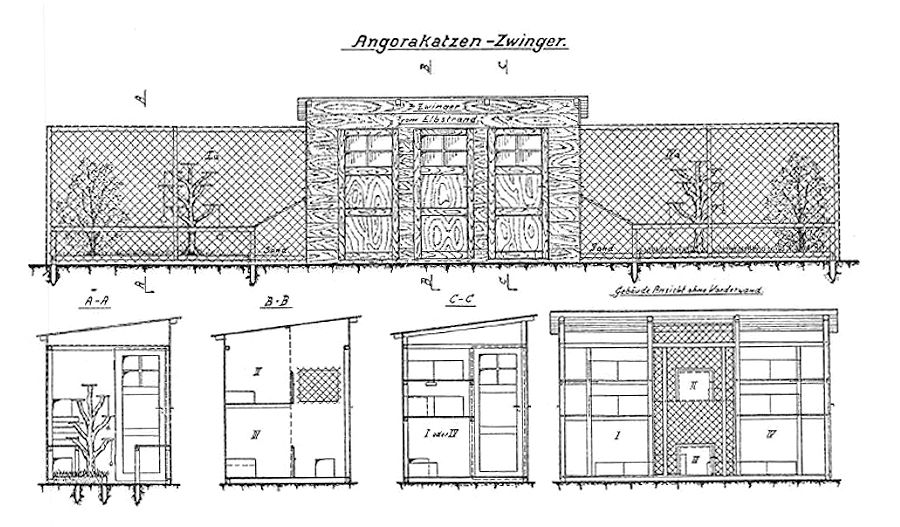
The so-called mating room II, is closed by a door and contains nothing except a litter box. The living room III is also completed by a small door and is equipped with a litter box and a resting-place. Rooms II and III have wire mesh fronts. Rooms I and IV have 4 resting boxes on the first and second floor and 2 litter boxes on the ground floor. Glass windows are installed in each door in order to for sufficient light to penetrate all the rooms,.
In the two kennels Ia and IVa, there are two benches, a climbing tree, a shadow tree, a small grass area and a sandpit. Here, the builder of the kennel can, at his own convenience, arrange all the items deemed necessary. The kennels themselves are surrounded on all sides with wire mesh 1 mm thick and at least 40 mm wide. At the top, the kennel can be half-covered with boards. The material used for the kennels and lounges are squared timbers 60 X 60 mm and grooved boards 1 inch thick. The roof of the building is covered with roofing felt.
The front of the whole complex faces east to give the animals as much sunshine as possible. The total length of the building is 4000 mm, the average height is 2100 mm and the width is 1700 mm. The doors are about 1700 mm high. The two kennels can be made 2 to 8 m long depending on the space available. All boards and squares must be coated with carbolineum [creosote] after assembly, in order to make them as weather-resistant as possible. The interior should be whitewashed.
In order to better understand the drawing, various cross-sections have been provided here. Cross-section A-A is a section through the kennels Ia and IVa viewed in the direction of the arrow; B-B is a section through the mating room II and maternity room III; section C - C viewed in the direction of the arrow is the section through cat rooms I and IV.
Experience has shown that cats feel good in the open air both in summer and in winter, and that even the most severe cold can not hurt them. Their appearance gets a wild animal look through their permanent stay in the open air.
PHOTOGRAPHING ANGORA CATS.
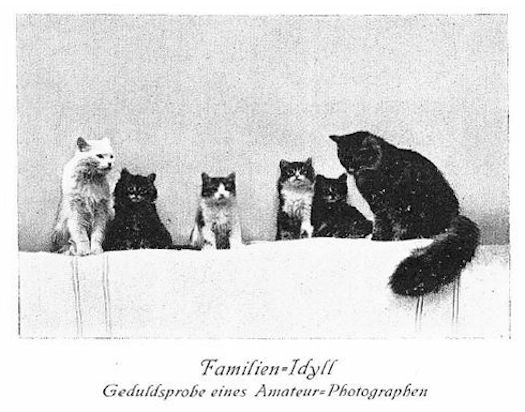
It is not easy to produce a beautiful picture of an Angora cat, as they are very lively and shy when they go in front of the camera. First and foremost, high-quality photographic apparatus is required for all photography, with at least an aperture of 4.5, a shutter speed up to 1/200 sec., and highly colour-sensitive, absolutely light-free plates of 20-23 degrees and, above all, nice weather.
The camera should be set up in advancet, and instead of the cat any object is used when setting up. Only when everything is ready is the animal put into the place, as experience has proved that the longer they spend in front of the camera, the more restless they become. The cat’s attention is attracted to the camera using some sort of a sound-producing device - a voice imitator, a rattle, a small bell or something else - and the snapshot can be taken in 1/25 of a second.
Backgrounds and settings. The cat’s colour must be matched with contrasting colours. For example, a white cat gets a dark background, while a black cat needs a bright background. For red cats, red-sensitive plates should be used.
When flash photography is needed, burn an ordinary light as, in most cases, the cats will close their eyes. A flash lamp, which can be triggered at any moment to create the flash, is necessary for this purpose. It goes without saying that artistic presentation, such as beautiful wallpaper or flowers in the background, contribute significantly to the image. Ruffs should be avoided as they give the cat an unnatural appearance.
Reflex cameras are the most suitable for cat photography as you can follow each movement of the animal and can adjust the camera again and again. Unfortunately these devices are very expensive.
If you want to photograph the head of a cat alone, cut a hole into thin card (which is a contrasting colour to the cat) and put it over the cat’s head. Pass some of the mane through the cardboard and the resulting portrait excellent. (See title page illustration).
If one wants to have a side view of the cat in the running position, place the camera on a board in a high position, and get everything ready in advance, then bring on the cat at the last moment. It will stand for a short time and it is only a matter of practice to take the snapshot at the right time. (Of course, the board must be equipped with two feet before shooting, so that it has a good standing.)
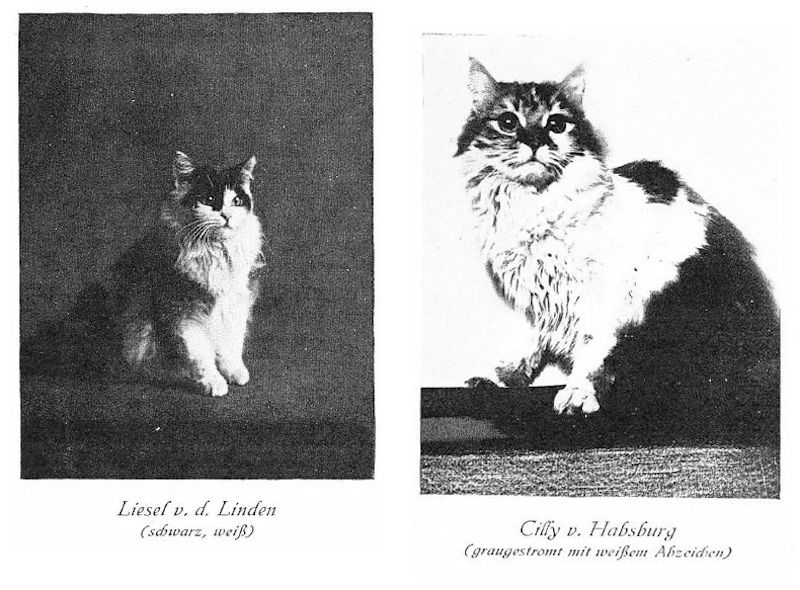
ANGORA CLUB HISTORY.
The first German Angora Cats Protection and Breeding Association E.V. Headquarters, Nuremberg, was founded on April 25, 1922. Until then the Angora cat was not widely kept in Germany despite its adaptability to man and home. Although cat lovers owned somed good animals, they could not be considered a breed as such. It was not until the founding of our club that it became possible to breed them systematically. A notice in a daily newspaper brought together 10 cat lovers from Nuremberg and Fürth to a meeting in the "Peter Henlein" guest house. The proposal to form an alliance for the benefit and protection of the Angora cat was warmly welcomed by all, and on that memorable evening the foundation stone of Angora cat history in Germany was laid. The meeting’s convenor, Mr. Willy Denkler, Nuremberg, is to be credited as the father of the idea. He was also commissioned by the small circle of the ladies: Herbst, Miederer, Speyer, Utz and the gentlemen: Böhringer, Dietz, Hirschmann, Horndasch, Weidinger-Nuremberg and Uttinger-Fürth to lead the club. Thanks to his active, unceasing advertising activity, the club tripled its membership in a very short time. Despite the fact that the Association was founded during an unfavourable time, the young club managed to overcome all obstacles. Although the associaiton suffered internal disputes these did not shake its established foundations. From time to time, concert and entertainment evenings were organized and helped to bring the members closer together and, last but not least, helped expand the circle of our prospective customers.
In order to get closer to our real goal, the promotion of the pure breeding of Angora cats, a breeding team was established in the same year. Our unfortunately already deceased first breeding director, Mr. Albert Rosenkranz, deserves special mention in this endeavour. In addition to the above-mentioned gentleman, Dr. Magerl and Dr. Mulzer deserve our gratitude.
Since only good specimens are eligible for approval, the Commission, chaired by Dr. Magerl, examines each animal according to a provisional pattern description. The breeding book (until then the first in Germany) has laid the foundation stone for a purposeful pure breed. In the current monthly meetings of scientists and practitioners, lectures on breeding and care are held to educate members and interested parties. Lectures on the theory of inheritance, etc., have been received with great interest.
The Association took great care that only first-class stud males were used. This soon showed success, so that in 1924 very good specimens were being produced. As in all areas, breeders should also be acknowledged here. The proposal made on March 3, 1924, in the "Hotel Sebald," by one of our most zealous supporters, our second chairman, Mr. Konrad Hirschmann gave general approval and enthusiasm, as well as laying out rules for holding a 1st German Angora cat exhibition, The decision to hold an exhibition was approved unanimously. Mr. Hirschmann was given the lead and thanks to his active, self-sacrificing activity the 1st German Angora Exhibition took place on the 13. -14. December 1924, with the help of the following ladies: Ms G. Bogner, Ms Dietz, Ms A. Herbst, Ms A. Utz, Ms Wangemann; and Men: H. Bogner, W. Denkler, L. Dietz, K. Horndasch, K. Junghändel, F. Reinhart, A. Rosenkranz. Since it was the first exhibition in this field, it aroused interest in all parts of Germany and beyond. It turned out that the event was crowned with success, and the number of members increased by twice as much during the exhibition, so that the assciation now embraced all of Germany. The leassons learnt from this exhibition were applied to future breeding.
With the steady growth membership, it was felt necessary to create a spiritual, therefore, a weekly section by the Angora Cat Club was introduced in an animal newspaper. As a result, the Association became the first of this kind in Germany to become increasingly widely known, and many, who at first only smiled quietly at our aims and ideas, saw that we were serious about our cause, and did not stand behind other Breed Associations. Thus, the 1st German Angora Cats Protection and Breeding Association E.V. headquarters in Nuremberg has the distinction of having established Angora cat breeding in Germany.
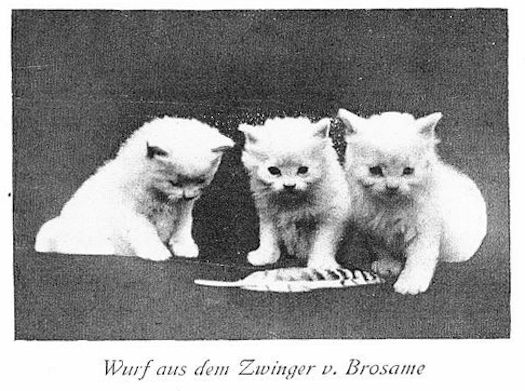
It is clear from our Association that we are also dedicated to the protection of our pets. The Association as a whole is connected to the animal protection association and opposes all ill-treatment of animals.
Our members are made up of all sections of the population. Volunteers perform all functions within the Association. In order to cope with our steadily growing correspondence, a typewriter was purchased at club costs, and a postal check and bank account were also created.
1926 was a very special challenge for the administrative members of the Association, as it had to prepare an exhibition. At the same time, this exhibition was to be accompanied by the publication of a book containing the breed standard description, together with essays on breeding, nursing and diseases of Angora cats.
Due to the increased requirements placed on the office, a Breeding Committee chaired by Dr. Dr. Magerl was seet up. This has the task of creating the greatest possible knowledge in this field. A lighting apparatus designed by our breeder committee member, Mr. Lenz, will exhibit images of the cats, and this gentleman also uses a camera specially bought for this purpose by the Association. Let these endeavours concisely show the purpose, nature, and aims of our organization to the benefit and prosperity of our good cause.
Good health to the noble breed!
1st German Angora Cats Protection and Breeding Association E.V., registered office in Nuremberg.
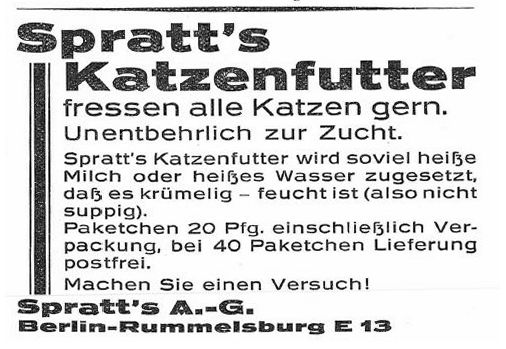
Spratt's cat food
Enjoyed by all cats.
Indispensable for breeding.
Spratt 's cat food is added to so enough hot milk or hot water that it is crumbly - moist (not supple).
Package 20 Pfg. Including packing, with 40 parcel delivery delivery post free.
Take a try!
Spratt's A.-G.
Berlin-Rummelsburg E 13
CONCLUSION.
When I look through this little work, I give heartfelt thanks to the staff: Frau Elisabeth Lenz, Nuremberg; the gentlemen: Konrad Hirschmann, Ottmar Lenz, Dr. Magerl, Fritz Reinhart, Nuremberg and Major Zapf, Bayreuth on behalf of the 1st German A Angora Cats Protection and Breeding Association E.V. Seat of Nuremberg for their selfless work the best thanks. May the contents of this book bring much benefit to all breeders and cat lovers, and not least to our pets! - W. Denkler, 1st Chairman.
We have a hearty request to the revered reader! If you encounter something that is inconsistent with your experiences or if we have missed anything important about the Angora cat in this booklet, please write down your observations and send them for the second edition at the Office of the 1st German Angora Cats Protection and Breeding Association EV headquarters at Nuremberg.
Thank you very much!
